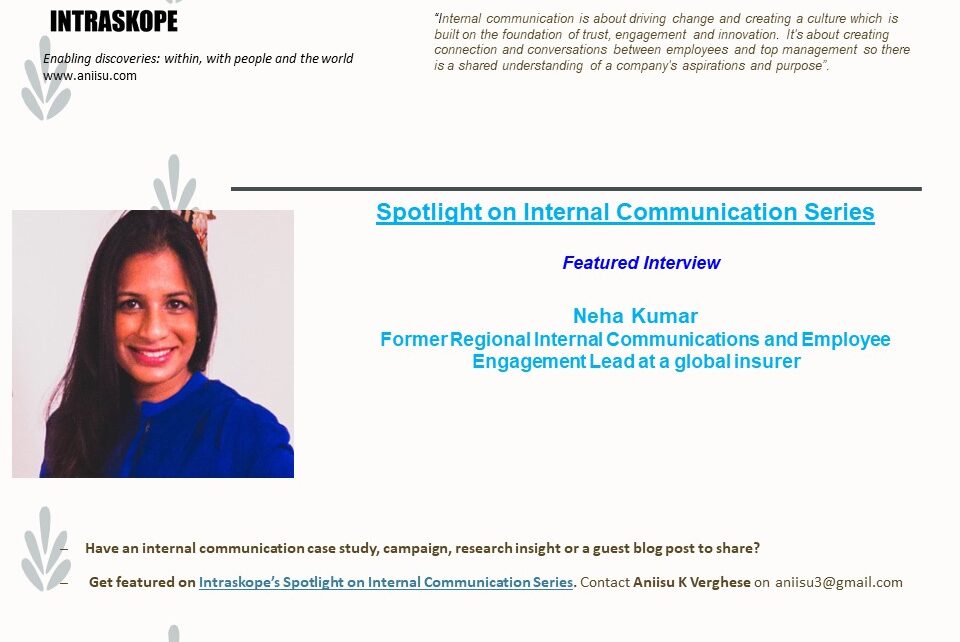Presenting the 40th edition of Intraskope’s Spotlight on Internal Communication Series featuring Neha Kumar. Watch the complete video interview on YouTube or read the transcript below. In her last assignment, Neha served as the Regional Internal Communications and Employee Engagement Lead at a global insurer based in Hong Kong. With over 15 years of experience in communications, as a journalist and a PR consultant Neha has done stints in Tokyo, Hong Kong and Singapore. Her grasp of English, Japanese and Hindi as well as her network of media contacts and key financial professionals in Asia allows her to thrive in a multicultural environment. In this interview, she shared her thoughts on the evolving domain and how internal communicators can harness technology, involve employees and drive thoughtful experiences. Read on.
1. What does internal communication mean to you?
In my view, internal communication is about driving change and creating a culture which is built on the foundation of trust, engagement and innovation. It’s about creating connection and conversations between employees and top management so there is a shared understanding of a company’s aspirations and purpose.
It’s also equally about giving a voice to employees so they can also feel empowered to reach the management with their thoughts, feedback and ideas.
2. How have you seen it practiced in the organizations you worked at?
I have worked at some great global organizations, who understand the importance of strong internal communications. They have kept things real, transparent and invested in tools to explore new ways of engaging and measuring success, which i believe is a key to achieve communication goals.
I have worked at companies where communication is two-way. It’s not just about top management relaying their message to employees but also organizations listening to their employees and reaching them on their terms – this approach needs to be inclusive of all – whether you are a contract employee or a permanent employee. Seeking honest feedback is equally important as that’s the only way to drive a change.
Humanizing the stories: It’s hard to engage with employees or invoke an action or change in behavior unless you keep things real, tell stories that can help simplify the complex and hit a chord.
Engaged and accessible leadership: Communications supports those in charge to be visible and accessible. Without engaged and accessible leaders, you aren’t going to have engaged and accessible employees.
3. Please share an example/campaign that you are personally proud of working on and that made a significant impact to an organization in the recent past
There are a few but the most recent one was creating a microsite on COVID-19 to keep employees informed of factual and accurate information. The microsite hosted a lot of information on facts about the virus, regular updates and Q&As from a medical professional, wellness-related content for which I interviewed the likes of a life coach, nutritionists to seek their views on how best to manage our health during these times. There was a lot of content on what my company and our people were doing to help our employees and our customers. I was very proud of this project and to be working for a company who had employees at the heart of everything they did.
4. What is the biggest challenge you face while going about managing internal communication? What according to you is the biggest opportunity that internal communicators have?
I think we have a long way from the days where communication was followed a top down only information flow. I think most corporates do understand the importance of engaging with employees, however, the methods of engaging with them are still quite traditional. Most would still only use the intranet, which is still a great channel, but I think companies need to start doing better. Reaching employees using the right technology can help massively, especially if a huge portion of your workforce is going to be millenniums and expect to be reached via their mobile phones. Showing flexibility and providing easy access to information so they can have whatever they need at their fingertips is the way forward. Investing in technology and tools that can host your internal content for information sharing and exchange is an opportunity. Newsletters, social networks, sharing videos and other content via emails are sometimes more effective ways than posting content on your intranet. Also, do check if you can make your internal technology better so people can have one-click access to information from their phones without having to deal with firewall issues or multiple log ins. You will lose your audience instantly if you have a layered process to seek that information and it will be a lost opportunity.
5. How can internal communicators add more value to the business?
I think we need to do more of engaging with employees in a way where they become your brand ambassadors. If we educate, excite and engage with the employees in a right way using the right tools and give employees a voice and create a culture of trust, empowerment, they would be best brand advocates and will result in lower turnover. Creating communities of brand ambassadors / advocates is a missed opportunity for many corporates. The culture a corporate creates inside a firm creates a meaningful experience for all stakeholders. And internal comms plays a huge role in helping shape that culture.
6. What skills must they have or develop?
Effective messaging – By that I don’t simply mean being a good writer. Of course, that’s needed, but it’s also understanding the tone of the message. Master empathy understand what we are trying to achieve and always put yourself in the shoes of your audience and think of message acceptance.
Be tactful and strategic: Speak up in team meetings as you are best placed to make a connection between an activity and its impact. You can make good ideas great ideas if delivered at the right time to the right audience using the right channels.
Build relationships and trust: Build strong relationships with not only leaders but colleagues across various departments. Truly listen to them and understand what they are saying and what their concerns are, solicit their feedback on initiatives/campaigns and find out how we can communicate better.
Be flexible: Lastly, show flexibility and be creative as there’ll be times you will be expected to roll with last-minute changes.
7. What is your advice for people who are keen to join internal communication and make a career?
Understanding your company’s vision and purpose, your audience, your culture and being able to communicate that in a way that’s inspiring is paramount to a company’s success. This is a job that requires you to not only have soft skills but also an understanding of business and work to influence and persuade and entire workforce to work towards a common goal. You will be in it to make impact and that’s so much more rewarding and meaningful than so many other careers.
8. What is your advice for women who want to make a mark in this domain and what must they do differently?
As you would know communications is represented strongly by women and that’s reflective of many skills, we naturally bring to the table. We are not only good communicators and listeners but we also have a stronger EQ, which goes a long way in this profession. A culture that emphasizes on compassion promotes a culture of teamwork, trust, empathy and collaboration.
My advice to you would be:
- Be brave and sign up for challenges. You may fail but that’s ok too – you make that a learning experience for when you try again.
- Be an early adopter of technology. It’s something I need to work on too.
- Have a strong network of communicators to gather insight and keep yourself updated with what’s new and what’s working with peers.
- Get a mentor, who’s also a great leader. It could be someone who is your advocate. Great leaders / mentors will have your back, encourage you to push boundaries, will empower you and bring the best in you. Do make sure you pay it forward when you become a great leader.
9. With COVID-19 and other crises, how must internal communications engage? What has changed or will change? Examples of how your organization has helped reassure employees and navigate the crisis as it unfolds.
COVID has changed the ways of working. I am so glad to see that most companies are now forced to look at newer ways of working as well as how they communicate with employees. Our role becomes more important than ever to help companies navigate through these challenging times and enable cross-functional collaboration, building a culture of trust where we empower them and engage with them and create a positive experience for them. I think this pandemic has made internal comms rethink their approach – how can we engage better and in an effective way and how do we encourage colleagues to connect more with each other, how we can help reduce their anxiety and still maintain productivity and morale.
As mentioned earlier, we did a few initiatives at my organization where quickly created a microsite, which was the central content hub for information pertaining to our guidelines, what we were doing for our staff, our customers, our communities, FAQs in accordance with new information, monthly calls with a medical expert for our employees, sharing sessions where colleagues who are parents shared their experiences.
10. Can you share one trend that you spot with internal communications?
Employees are increasingly seen as internal influencers and their content is increasingly integral to internal comms. Enabling people to share information, communicate and interact actively leads to better culture of collaboration and exchange of information. This is also so important to engage with the millennials, who now make a large share of working population. They question the top-down structure and want more collaboration and want to be heard.
11. If there is one aspect of internal communications you would like to change, what would that be?
Change is necessary to improve business. I think with the new norm of more and more people working from home and companies going through digital transformation, we communicators need to change as well in how we adopt the process of new technology to engage with the entire population and communicate more effectively with those who are working remotely. Investing in good tracking tools so you can measure success and track your strategy against it. I think the one change that might be imperative for us would be tracking data on communications efforts and accordingly having targeted messaging. Gone are the days when you could have blanket messaging for all. The relevance of content and the channel used are so important in today’s time and age.
Liked the interview? Post your comments and share it with your network.
Keen to contribute and participate in the ongoing series on Intraskope where we put the spotlight on thought leadership, great ideas, and practical solutions? Look up the previous stories from organizations featured on the Intraskope’s Spotlight on Internal Communication Series here – Standard Chartered Bank, BASF, Applied Materials India, Microsoft UK, Times Group, Samsung, Falabella, Brillio, UAE Exchange, Apeland, M.H. Alshaya Co, Proctor & Gamble, Infosys, SOBHA Ltd., ICICI Securities, First Advantage, CK Birla Group, TVS Motors, GE, Suzlon, Tata Sons, Percept, Knight Frank, TCS Europe, Vedanta, Oxfam, Danske Bank, Diageo, Pandora, Symantec, ISS Global Services, Telia, Thomson Reuters, IBM, General Motors, Intelligence India Software Solutions and Philips.
Intraskope (www.aniisu.com) is the first blog on internal communications in India and among the earliest around the globe. Begun in 2006, the blog has over 1000 posts on topics such as employee engagement, leadership communication and employee branding and receives thousands of visits from across the world. The blog, receives over 1,50,000 visits every month from over 50 countries globally, offers learning resources for practitioners, academicians, and students including industry workshops, research reports, and checklists.
Intraskope has been featured on leading global internal communication forums like Simply-Communicate, IC Kollectif and International Association of Business Communicators. It is hosted by Aniisu K Verghese, author of Internal Communications – Insights, Practices & Models (Sage, 2012).
If you are an internal communication leader working in a firm or a not-for-profit anywhere in the world and have an internal communication case study, campaign, research insight or a guest blog post to share please contact me on aniisu3@gmail.com
Here are Internal Communications resources you can use:
• Internal Communications Series: https://forms.gle/KcqmPzLwq7NQi5Km6
• Chat with Aniisu – Internal Communications: https://www.instamojo.com/intraskope/connect-with-aniisu-60-minute-personalized-d/?ref=store
• Internal Communications workshops: https://bit.ly/2zdBRl1
You can also visit my website www.intraskope.com and You Tube channel to know more about my work.


